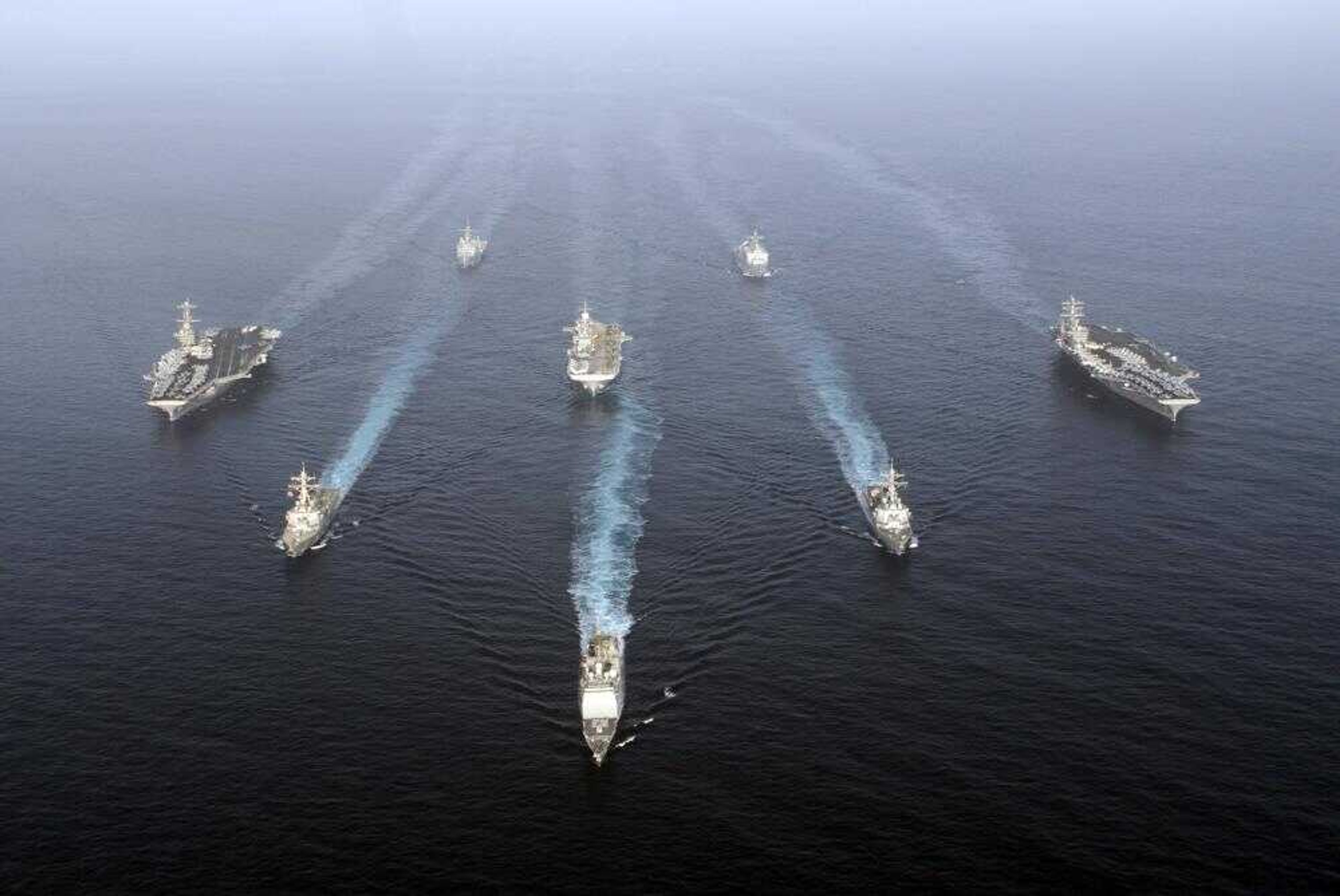U.S. Navy launches show of force off Iran's coast ahead of talks
DUBAI, United Arab Emirates -- Ships packed with 17,000 sailors and Marines moved into the Persian Gulf on Wednesday as the U.S. Navy staged another show of force off Iran's coast just days before U.S.-Iran talks in Baghdad. The carrier strike groups led by the USS John C. Stennis and USS Nimitz were joined by the amphibious assault ship USS Bonhomme Richard and its own strike group, which includes two landing ships carrying 2,100 members of the 13th Marine Expeditionary Unit...
~ The ships ran submarine, mine and other exercises.
DUBAI, United Arab Emirates -- Ships packed with 17,000 sailors and Marines moved into the Persian Gulf on Wednesday as the U.S. Navy staged another show of force off Iran's coast just days before U.S.-Iran talks in Baghdad.
The carrier strike groups led by the USS John C. Stennis and USS Nimitz were joined by the amphibious assault ship USS Bonhomme Richard and its own strike group, which includes two landing ships carrying 2,100 members of the 13th Marine Expeditionary Unit.
Aircraft aboard the two carriers and the Bonhomme Richard were to conduct air training while the ships ran submarine, mine and other exercises.
The war games -- which culminate in an amphibious landing exercise in Kuwait, just a few miles from Iran -- appear to be a clear warning to Tehran, coming just ahead of the Baghdad talks and as the United Nations contemplates tightening sanctions against Iran over its nuclear program.
"There's a link to both events," said Mustafa Alani of the Dubai-based Gulf Research Center. "The Americans are sending a message to Iran that they are not coming to the negotiating table weak, but with their military at Tehran's doorstep."
Washington is also showing Iran that the U.S. military will act to defeat any Iranian war strategy of closing the straits, which Iran shares with Oman, Alani said.
U.S. and Iranian ambassadors are to meet Monday in Baghdad to discuss Iraq's security issues. Tehran has objected to U.S. claims that Iran is supplying Iraqi Shiite militias with roadside bombs that kill American troops.
The United States has also accused Iran of covertly developing nuclear weapons; Iran says its nuclear program is peaceful.
Publicly, at least, the Navy isn't saying the maneuvers, which are expected to last several weeks, are directed at Iran.
"The timing of the exercise was determined by the availability of forces in the area of operations," said Lt. John Gay, spokesman for the Bahrain-based U.S. 5th Fleet. Warships under 5th Fleet command patrol the Gulf, Arabian Sea and Indian Ocean.
The nine ships taking part in the maneuvers were already on patrol in Mideast waters outside the Gulf when they passed through the Strait of Hormuz on Wednesday and began air and sea maneuvers in the Gulf. Two-fifths of the world's oil is transported through the busy straits.
"This training demonstrates our commitment to security and stability in the Gulf area and our commitment to regional partners," said Vice Admiral Kevin J. Cosgriff, commander of 5th Fleet.
Wednesday's drill was the latest in a series of American and Iranian war games. Iran conducted naval maneuvers in November and April 2006, while the U.S. Navy held a two-carrier exercise in March and a training operation in October.
The Navy has maintained its two-carrier presence since February when the Stennis arrived in the Mideast waters. Both carriers, with about 80 warplanes apiece, are expected to remain in the region through the summer.
Besides the Stennis, Nimitz and Bonhomme Richard, the war games bring together the guided-missile cruiser USS Antietam and USS Princeton, the destroyers USS O'Kane and USS Higgins, and the landing ships USS Denver and USS Rushmore.
America's Gulf Arab allies have grown increasingly uneasy with the U.S. stance against Iran, fearing an outbreak of hostilities could bring Iranian retaliation. All lie within range of Iranian missiles.
The Gulf Cooperation Council, a loose alliance of Kuwait, Qatar, Oman, Saudi Arabia, Bahrain and the United Arab Emirates, has called on members not to support any U.S. action against Iran, while Qatar and the Emirates have publicly prohibited the U.S. military from launching strikes on Iran from U.S. bases on their soil.
During a landmark visit to the Emirates this month, Iranian President Mahmoud Ahmadinejad warned of a tough retaliation if the United States attacked Iran. He also called on Gulf Arab states to eject the U.S. military and form a regional alliance with Iran -- an offer that met no response.
Connect with the Southeast Missourian Newsroom:
For corrections to this story or other insights for the editor, click here. To submit a letter to the editor, click here. To learn about the Southeast Missourian’s AI Policy, click here.








